AirCare for Buildings
In this new era, energy management software is the AirCare for buildings and building automation system suppliers and contractors and energy consultants are the auto repair shops.
|
May 2012 |
[an error occurred while processing this directive] |
|
AirCare for Buildings In this new era, energy management software is the AirCare for buildings and building automation system suppliers and contractors and energy consultants are the auto repair shops. |
| Articles |
| Interviews |
| Releases |
| New Products |
| Reviews |
| [an error occurred while processing this directive] |
| Editorial |
| Events |
| Sponsors |
| Site Search |
| Newsletters |
| [an error occurred while processing this directive] |
| Archives |
| Past Issues |
| Home |
| Editors |
| eDucation |
| [an error occurred while processing this directive] |
| Training |
| Links |
| Software |
| Subscribe |
| [an error occurred while processing this directive] |
In the Lower Mainland of British Columbia, you can’t insure your
vehicle unless it passes AirCare. When you bring your vehicle to
the AirCare centre, they run a series of tests to make sure that all of
the emissions control systems are working as intended. If you
fail any of the tests, you need to take it to a mechanic for a tune-up
or repair within 90 days. It’s essentially a retro-commissioning
program for vehicles with a check point every two years.
Everyone wins in this arrangement.
Can you
imagine what the test results would show if such a
comprehensive program was rolled out to the commercial building
stock? It’s rare to walk into a building today and find it
operating at peak efficiency. Fortunately, that is changing and
continuous commissioning is gaining acceptance as the standard way to
operate a building.
In this new era, energy management software is the AirCare for
buildings and building automation system suppliers and contractors and
energy consultants are the auto repair shops. Through close
collaboration, those two groups will both benefit and will work
together to benefit the customer and the environment.
Pulse Energy plays an important role in continuous commissioning
through our Pulse Energy Manager product which provides market leading
building-level energy intelligence. Founded in
2006 we provide a product family for commercial buildings and
utilities that spans from energy management software to occupant and
community engagement. All products are
delivered as a SaaS model. The products are delivered to
commercial buildings directly, through consultants and through utility
energy conservation programs. With hundreds of millions of square
feet under management, the company works effectively with many
different types of service providers, utilities and vendors to bring
value to building owners.
The following examples demonstrate the role that Pulse Energy Manager
can play to identify opportunities to optimize building automation
systems.
Example 1: Catching drift and anomalies using the Pulse Adaptive Model
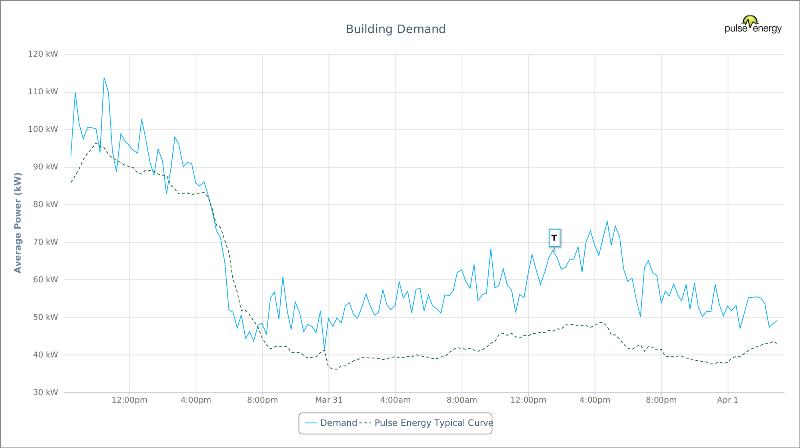
Once a
building has been properly commissioned, an energy model can be
built to determine how much energy that building would ideally use
under a wide range of circumstances. This model then serves as a
baseline that can be used to identify drift in the performance of the
building over time or specific anomalies related to equipment
malfunctions or improper adjustments to the building controls.
Traditional linear regression methods are generally used to generate a
weekly or monthly energy number and so they don’t provide the level of
detail that is needed. The Model generates a
prediction for every 15 minute period of the day; allowing users to
immediately recognize when something has gone awry. In the above
example, it’s seen that the building is performing well on a weekday
but the weekend energy consumption is now 20% higher than it should
be. This is a clear indication that the building is due for
recommissioning.
Example 2: Avoiding peak demand charges by using a Load Duration Curve
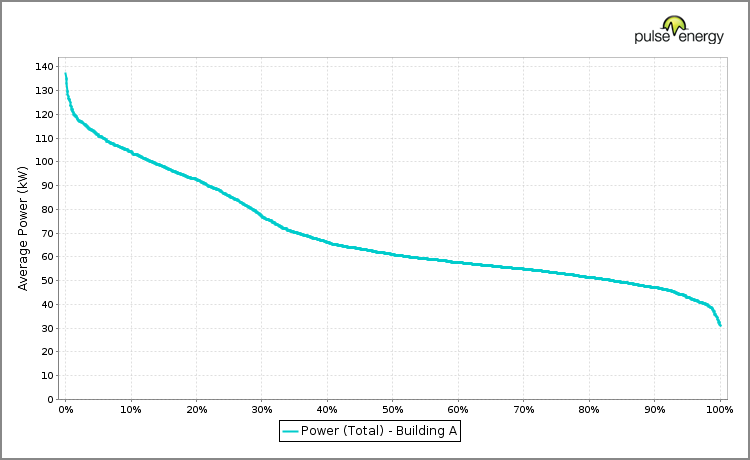
A Load Duration Curve is an effective tool for determining the percentage of time that is spent at the highest demand levels. Since a building’s peak demand charge is based only on the highest 15 minutes in a billing period, it’s important to know how much time is spent at that level of consumption. In the above diagram, the steep angle of the slope near 0% shows that a large proportion of the demand charge can be attributed to a small handful of hours. This represents an opportunity for a control or operations strategy to be implemented that shift peak demand for a handful of hours to reduce peak demand charges with a minimal impact on occupants.
Example 3: Identifying unnecessary operating hours
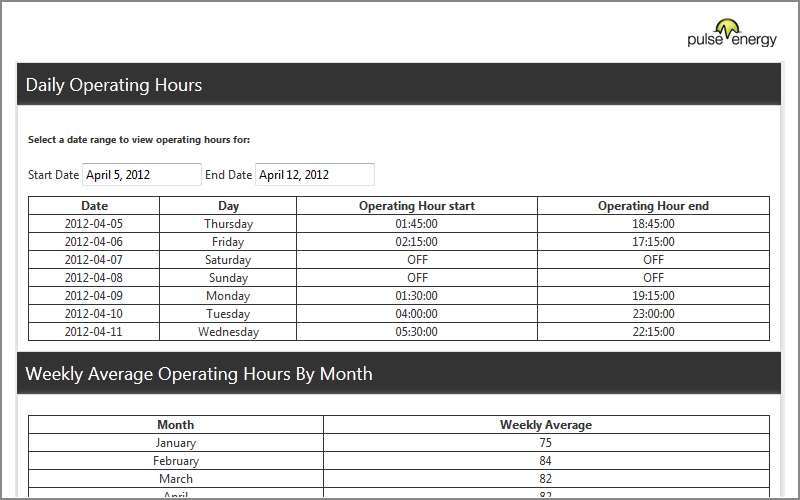
One of the most common opportunities for energy conservation in commercial buildings is tightening up the effective operating hours. We all have seen similar version of the same story. A building is configured to turn on at 8am and off at 6pm. Then someone starts coming into work early so the turn on point is moved to 7am. A few months later a special project comes up and people need to work late for a month so the shutdown time is moved down to 9pm. A month after that a weekly speaking series is set up and so now the shutdown time on Wednesdays is moved to 10pm. Long after the early bird employee has moved on, the project has been finished and the speaking series has been moved to a new venue, the building controls are still faithfully keeping the lights and heat on during these extended hours. Currently in a Beta testing stage, we will soon be releasing an operating hours analysis tool that analyzes the load profiles and automatically determines the effective operating hours of the building on each day. The report shows weekly averages for each month and the daily averages for each day of the week. This report allows a Building Automation System professional to quickly narrow in on issues and determine where things went wrong.
Example 4: Digging deeper
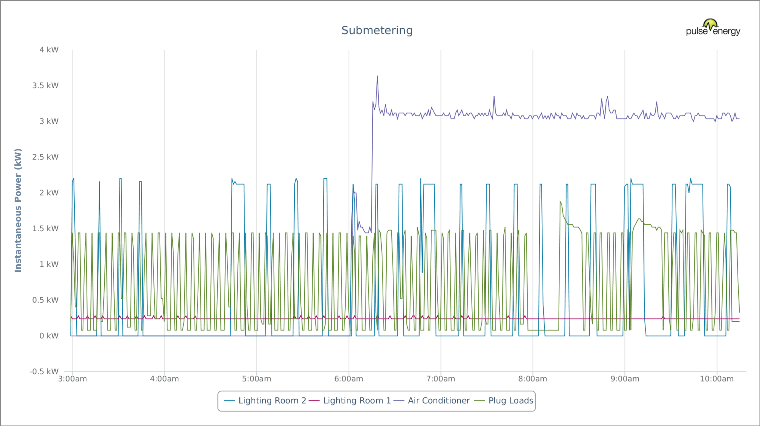
In addition to the building energy consumption, there are many advantages to pulling in additional submeter points, advanced power monitoring points or BAS points into your Energy Management Software. The flexible charting and reporting functionality in a tool like Pulse Energy Manager can allow a professional to quickly troubleshoot everything from voltage imbalances to the root cause of power consumption spikes.
Example 5: Identifying abnormally high consumption through benchmarking

There
are limits to what can be achieved through improved controls and
control strategies. Some buildings are just leaky energy hogs
filled with equipment that should have been retired decades ago.
That type of an issue can’t be identified by looking at load profiles
in isolation. The Energy Manager allows users to benchmark the
building against buildings of a similar size and use to determine how
much potential there is for further savings through retrofits and
equipment upgrades.
Similar to AirCare, there is a validation step after improvements are
made in a building. Our Adaptive Model produces an accurate
calculation of how much energy a building would have used today if
changes had not been made. Often acting as a third party, we are
in an ideal position to provide unbiased verification of the
significant savings that are achieved through continuous
commissioning. These validated savings are the justification for
continued investment in the continuous commissioning process.
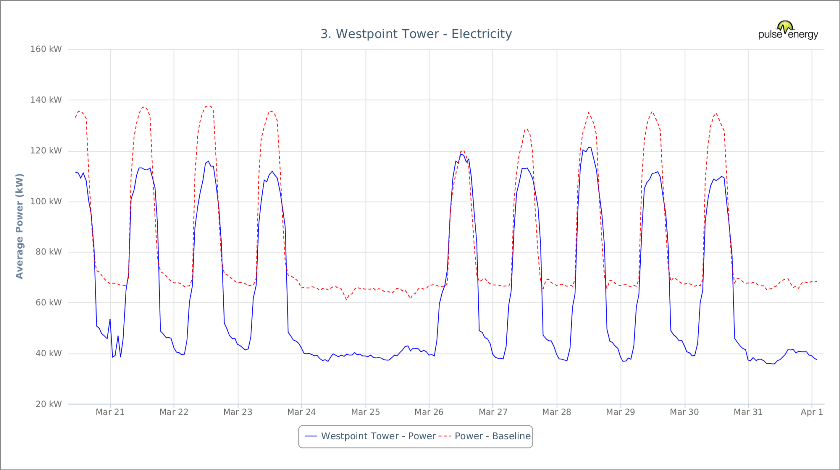
[an error occurred while processing this directive]
The AirCare program in
British Columbia has been a significant
success. It identifies over 30,000 vehicles per year that are
polluting excessively and it does so using a systematic and efficient
approach. As building automation professionals, we can look to
this program for ideas about how to structure our own industry.
Pulse Energy Manager plays an important role in the continuous
commissioning process and we are interesting in working with customers,
service providers and vendors that are driving buildings towards peak
efficiency.
About Pulse Energy and the Author
Pulse Energy was founded in 2006 with the goal of leveraging technology
and energy intelligence to reduce waste and improve operational
efficiency in the world’s commercial and institutional buildings.
The Pulse Energy team created an energy intelligence solution of
unrivaled accuracy and ease of use by designing an entire software
platform around the needs of utility efficiency program managers,
energy managers and executives. With this solution in place the team
has focused its efforts on the growing opportunity for utilities to use
Pulse as a platform to collaborate with their commercial customers on
energy efficiency. With Pulse, utilities are able to promote energy
intelligence, support efficiency objectives, meet regulatory
requirements and improve customer satisfaction.
Steve Jones is the Product Manager at Pulse Energy. Steve has
been with the company since 2007 and joined shortly after it was
founded. He has a degree in Engineering Physics with a
specialization in Electrical Engineering from the University of British
Columbia. He has been a member of the Vancouver Board of Trade
Sustainability Committee and has volunteered through the Vancouver
School Board Mentorship Program. Steve is also an avid hiker and nature
photographer and a Canadian national paper airplane champion.
[an error occurred while processing this directive]
[Click Banner To Learn More]
[Home Page] [The Automator] [About] [Subscribe ] [Contact Us]